These rolling ghosts remind us of the need to take control of public transport in Haiti, a crucial sector, abandoned by the State, occupied by working-class people with limited financial means.
“Wandering piles of scrap metal!”
Patrice Valembrun reserves the flowery expression for the buses in his neighborhood, Christ-Roi.
“It is common knowledge that these vehicles are perpetually in a state of disrepair,” shares the man with a touch of irony.
Clothes tearers, strong smells of smoke… Christ-Roi buses do indeed have a bad reputation.
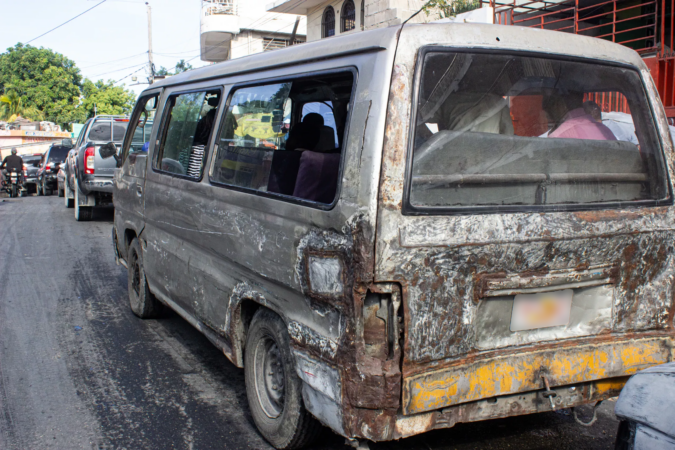
An old minibus providing passenger transport to Christ-Roi is spotted on the Nazon road in November 2023. | © Jean Feguens Regala/AyiboPost
These rolling ghosts remind us of the need to take charge of public transport in Haiti, a crucial sector, abandoned by the State and occupied by proletarians with limited financial means.
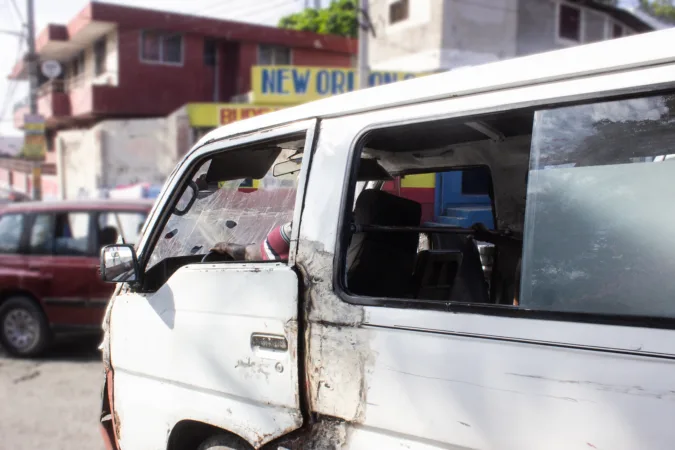
An old minibus from Christ-Roi is seen with the driver’s side door unable to close in November 2023 in Port-au-Prince. | © Jean Feguens Regala/AyiboPost
A decree from May 26, 2006 serves as a code for the road. It requires seat belts and prohibits glasses, demands respect for the road and encourages the use of a driver’s license.
This rarely applied decree does nothing to prevent the dilapidation of public transport cars, which are generally poorly maintained, uncontrolled and endangering the lives of users.
“Despite debates on this subject, no concrete action has been taken and the establishment of order in this sector is not considered a major concern for the government,” says Méhu Changeux, coordinator of the Haitian Ground Transport Sector (STTH).
Most of the circuit ventures into urban art. This is the case of Carrefour-Feuilles with its colorful music clubs on four wheels, poetically named Bwafouye.
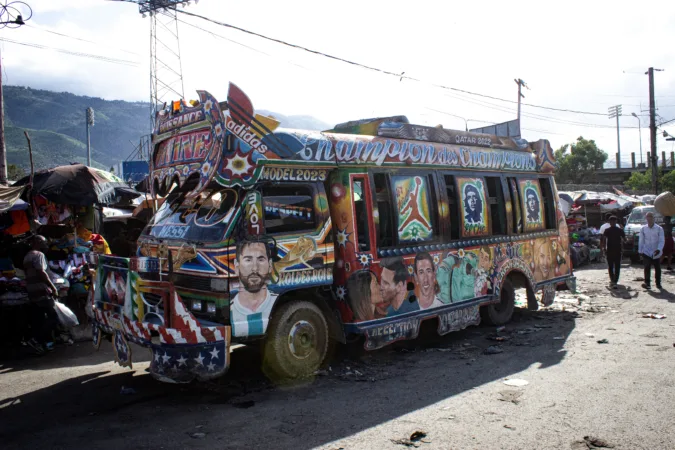
A rundown bus from the commune of Carrefour waits for passengers at the station near the Sylvio Cator Stadium in Port-au-Prince in November 2023.| © Jean Feguens Regala/AyiboPost
These buses carry life-size portraits of Hollywood or football stars, when they do not display spicy slogans, sometimes unpleasant, but full of wisdom.
Wisdom. Certainly. But here again, passengers complain of overcrowding, stifling heat, and sometimes excessive loudness.
Originality escapes other routes. Christ-Roi remains perhaps the most distinctive leg. Lucien Pierre knows something about this: he has been a bus driver in the area since 2005.
According to the bright eyed shaggy bearded man, the circuit’s buses are discarded antiques, transferred to Christ-Roi to die.
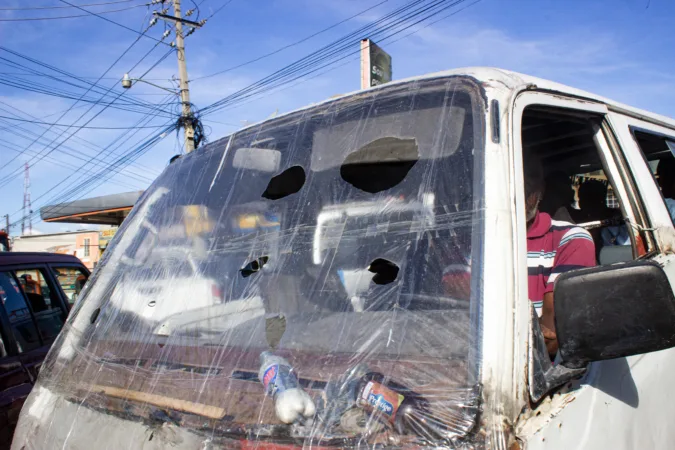
A plastic mat serves as the missing windshield of a rundown minibus from Christ-Roi in November 2023. | © Jean Feguens Regala/AyiboPost
The dilapidation becomes proof of authenticity. “Passengers refuse to board buses in good condition on the circuit because they don’t look like the type of vehicles usually used for this route,” he maintains.
Drivers like Wilfrid Dieu, on this route since 1994, strive to put on a good face. But the man complains of deteriorating returns due to insecurity.
In Haiti, public transport vehicles sometimes drive without indicators, devoid of rear-view mirrors, with passengers crammed everywhere except on the four wheels.
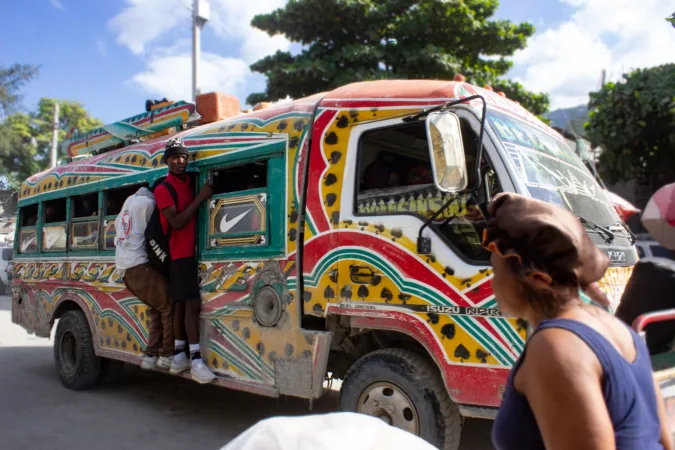
A crowded bus heading towards Portail Léogane in Port-au-Prince in November 2023. | © Jean Feguens Regala/AyiboPost
Discomfort breeds complaints, obviously. Marie-Junie Joseph had an appointment with a dentist in La Plaine in June 2020.
Dressed to the highest end of her budget, Marie-Junie took her seat on a “very dirty” bus carrying merchants who had just bought piles of supplies. So-called simple passengers are generally mixed with heavy goods. “When I got out, my clothes were dirty and wrinkled,” complains Marie-Junie.
The buses serving Bon-Repos stand out with their yellow and black color palettes, associated with school transportation in the United States and Canada. These large carriers are profitable, according to drivers like Noël Pascal.
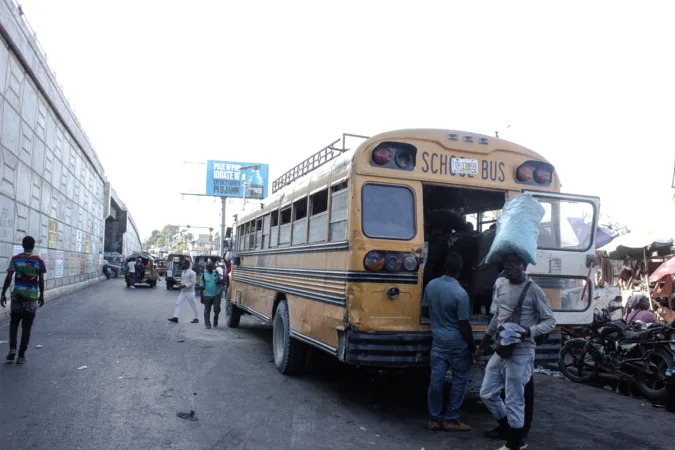
A bus operating the Carrefour Aéroport/Bon Repos route in November 2023. | © Jean Feguens Regala/AyiboPost
The man notes that buses heading to Bon Repos city center are often “ less clean than those servicing the Bon Repos airport.”
Pascal has his own theory: regular non-payment of fares by users, but also the frequent presence of goods, inevitably contributing to the deteriorating cleanliness of vehicles.
The unions, faced with the precariousness of drivers, are expressing their limits. “This situation creates a mess where safety standards are often neglected, and transport prices fluctuate in an uncontrolled manner,” analyzes Petrus Eustache Lerice, administrator of the Association of Owners and Drivers of Haiti (APCH).
For this trade unionist, transport in Haiti remains an informal sector. And it is up to the State to come to the rescue with appropriate regulations, the necessary road infrastructure and above all, “financial support” for drivers.
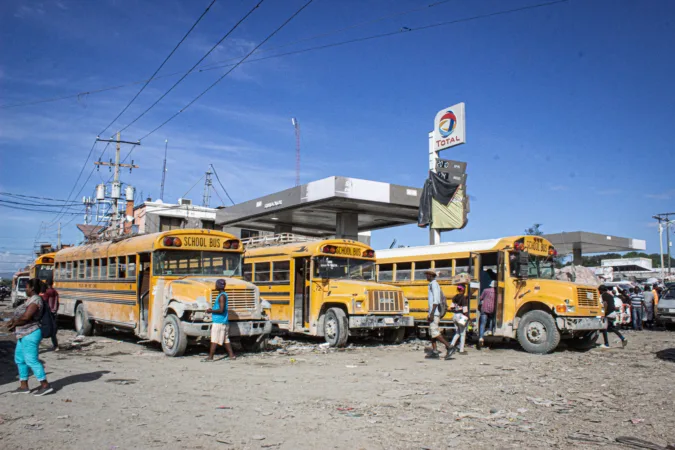
Buses from the Carrefour municipality waiting for passengers at a station near the Sylvio Cator Stadium in November 2023. | © Jean Feguens Regala/AyiboPost
This would do a world of good for users of the Pétion-ville-Jacquet circuit, with its minibusses generally carrying more passengers than their intended capacity. “These vehicles are poorly maintained and uncomfortable,” complains Roody Beauchamps, a resident of Jacquet.
Jean-Baptiste Bernard, driver and president of the Jacquet bus union, denies this. “As drivers, our economic situation is difficult, which limits our ability to take certain measures,” the man said.
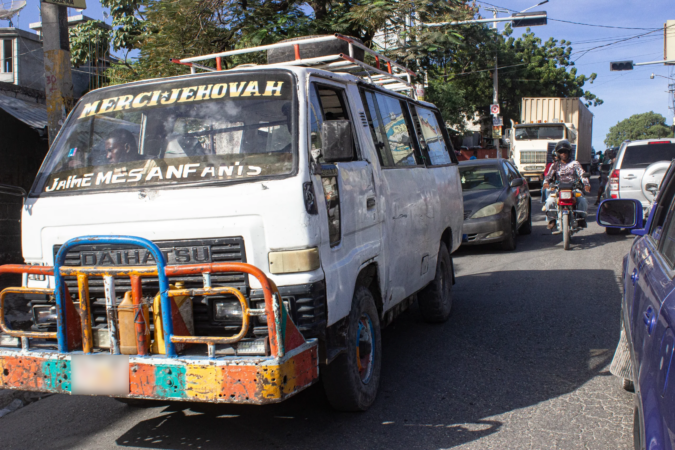
A Christ-Roi minibus spotted in Lalue, Port-au-Prince, in November 2023. | © Jean Feguens Regala/AyiboPost
Ultimately, all roads lead to the State.
The State which must regulate.
The State which must implement stated rules.
Méhu Changeux, coordinator of the STTH, supports this argument.
“A country’s transportation system is a mirror of its own identity,” says Changeux. “It is the State’s responsibility to supervise and regulate,” he maintains.
Cover image: A close-up view of the dilapidation of a minibus from Christ-Roi, observed in Nazon in November 2023. | © Jean Feguens Regala/AyiboPost
Stay in touch with AyiboPost through :
► Our WhatsApp channel : click here
► Our WhatsApp Community : click here
► Our Telegram canal : click here







Comments